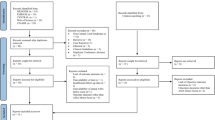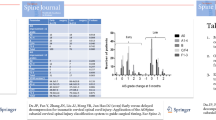Abstract
Purpose
Spinal Cord Society (SCS) and Spine Trauma Study Group (STSG) established a panel tasked with reviewing management and prognosis of acute traumatic cervical central cord syndrome (ATCCS) and recommend a consensus statement for its management.
Methods
A systematic review was performed according to the PRISMA 2009 guidelines. Delphi method was used to identify key research questions and achieve consensus. PubMed, Scopus and Google Scholar were searched for corresponding keywords. The initial search retrieved 770 articles of which 37 articles dealing with management, timing of surgery, complications or prognosis of ATCCS were identified. The literature review and draft position statements were compiled and circulated to panel members. The draft was modified incorporating relevant suggestions to reach consensus.
Results
Out of 37 studies, 15 were regarding management strategy, ten regarding timing of surgery and 12 regarding prognosis of ATCCS.
Conclusion
There is reasonable evidence that patients with ATCCS secondary to vertebral fracture, dislocation, traumatic disc herniation or instability have better outcomes with early surgery (< 24 h). In patients of ATCCS secondary to extension injury in stenotic cervical canal without fracture/fracture dislocation/traumatic disc herniation/instability, there is requirement of high-quality prospective randomized controlled trials to resolve controversy regarding early surgery versus conservative management and delayed surgery if recovery plateaus or if there is a neurological deterioration. Until such time decision on surgery and its timing should be left to the judgment of physician, deliberating on pros and cons relevant to the particular patient and involving the well-informed patient and relatives in decision making.
Graphic abstract
These slides can be retrieved under Electronic Supplementary Material.






Similar content being viewed by others
Change history
20 November 2020
A Correction to this paper has been published: https://doi.org/10.1007/s00586-020-06654-7
References
Hayes KC, Hsieh JT, Wolfe DL et al (2000) Classifying incomplete spinal cord injury syndromes: algorithms based on the international standards for neurological and functional classification of spinal cord injury patients. Arch Phys Med Rehabil 81:644–652
Kretzer RM (2016) A clinical perspective and definition of spinal cord injury. Spine (Phila Pa 1976) 41(Suppl 7):S27. https://doi.org/10.1097/brs.0000000000001432
McKinley W, Santos K, Meade M, Brooke K (2007) Incidence and outcomes of spinal cord injury clinical syndromes. J Spinal Cord Med 30:215–224
Schneider RC, Cherry G, Pantek H (1954) The syndrome of acute central cervical spinal cord injury. J Neurosurg 11:546–577. https://doi.org/10.3171/jns.1954.11.6.0546
Schneider RC, Thompson JM, Bebin J (1958) The syndrome of acute central cervical spinal cord injury. J Neurol Neurosurg Psychiatry 21:216–227
Dai L, Jia L (2000) Central cord injury complicating acute cervical disc herniation in trauma. Spine (Phila Pa 1976) 25:331–336. https://doi.org/10.1097/00007632-200002010-00012
Bose B, Northrup B, Osterholm J, Cotler J (1984) Reanalysis of central cervical cord injury management. 1–2
Chen TY, Lee ST, Lui TN et al (1997) Efficacy of surgical treatment in traumatic central cord syndrome. Surg Neurol 48:435–441. https://doi.org/10.1016/S0090-3019(97)00037-2
Chen TY, Dickman CA, Eleraky M, Sonntag VK (1998) The role of decompression for acute incomplete cervical spinal cord injury in cervical spondylosis. Spine (Phila Pa 1976) 23:2398–2403
Guest J, Eleraky MA, Apostolides PJ et al (2002) Traumatic central cord syndrome: results of surgical management. J Neurosurg 97:25–32
Yamazaki T, Yanaka K, Fujita K et al (2005) Traumatic central cord syndrome: analysis of factors affecting the outcome. Surg Neurol 63:95–99. https://doi.org/10.1016/j.surneu.2004.03.020
Lenehan B, Fisher CG, Vaccaro A et al (2010) The urgency of surgical decompression in acute central cord injuries with spondylosis and without instability. Spine (Phila Pa 1976) 35:S180–S186. https://doi.org/10.1097/brs.0b013e3181f32a44
Moher D, Liberati A, Tetzlaff J, Altman DG (2009) Preferred reporting items for systematic reviews and meta-analyses: the PRISMA statement. PLoS Med 6:e1000097. https://doi.org/10.1371/journal.pmed.1000097
Picot J, Hartwell D, Harris P et al (2012) The effectiveness of interventions to treat severe acute malnutrition in young children: a systematic review. Health Technol Assess 16:1–316. https://doi.org/10.3310/hta16190
Thorburn W (1887) Cases of injury to the cervical region of the spinal cord. Brain 9:510–543. https://doi.org/10.1093/brain/9.4.510
Collignon F, Martin D, Lenelle J, Stevenaert A (2002) Acute traumatic central cord syndrome: magnetic resonance imaging and clinical observations. J Neurosurg 96:29–33
Schneider RC (1959) Chronic neurological sequelae of acute trauma to the spine and spinal cord. II. The syndrome of chronic anterior spinal cord injury or compression; herniated intervertebral discs. J Bone Joint Surg Am 41-A:449–456
Schneider RC (1960) Chronic neurological sequelae of acute trauma to the spine and spinal cord. Part V. The syndrome of acute central cervical spinal-cord injury followed by chronic anterior cervical-cord injury (or compression) syndrome. J Bone Joint Surg Am 42-A:253–260
Bosch A, Stauffer ES, Nickel VL (1971) Incomplete traumatic quadriplegia. A ten-year review. JAMA 216:473–478
Jin W, Sun X, Shen K et al (2017) Recurrent neurological deterioration after conservative treatment for acute traumatic central cord syndrome without bony injury: seventeen operative case reports. J Neurotrauma. https://doi.org/10.1089/neu.2016.4706
Rand RW, Crandall PH (1962) Central spinal cord syndrome in hyper-extension injuries of the cervical spine. J Bone Joint Surg Am 44-A:1415–1422
Shrosbree RD (1977) Acute central cervical spinal cord syndrome–aetiology, age incidence and relationship to the orthopaedic injury. Paraplegia 14:251–258. https://doi.org/10.1038/sc.1976.42
Maxted MJ, Dowd GSE (1982) Acute central cord syndrome without bony injury. Injury 14:103–106. https://doi.org/10.1016/S0020-1383(82)80022-3
Morse SD (1982) Acute central cervical spinal cord syndrome. Ann Emerg Med 11:436–439
Ishida Y, Tominaga T (2002) Predictors of neurologic recovery in acute central cervical cord injury with only upper extremity impairment. Spine (Phila Pa 1976) 27:1652–1658. https://doi.org/10.1097/00007632-200208010-00011(discussion 1658)
Brodkey JS, Miller CF Jr, Harmody RM (1980) The syndrome of acute central cervical spinal cord injury revisited. Surg Neurol 14:251–257
Song J, Mizuno J, Nakagawa H, Inoue T (2005) Surgery for acute subaxial traumatic central cord syndrome without fracture or dislocation. J Clin Neurosci 12:438–443. https://doi.org/10.1016/j.jocn.2004.04.008
Uribe J, Green BA, Vanni S et al (2005) Acute traumatic central cord syndrome - Experience using surgical decompression with open-door expansile cervical laminoplasty. Surg Neurol 63:505–510. https://doi.org/10.1016/j.surneu.2004.09.037
Pollard ME, Apple DF (2003) Factors associated with improved neurologic outcomes in patients with incomplete tetraplegia. Spine (Phila Pa 1976) 28:33–39. https://doi.org/10.1097/01.brs.0000038180.84128.c4
Aito S, D’Andrea M, Werhagen L et al (2007) Neurological and functional outcome in traumatic central cord syndrome. Spinal Cord 45:292–297. https://doi.org/10.1038/sj.sc.3101944
Furlan JC, Noonan V, Cadotte DW, Fehlings MG (2011) Timing of decompressive surgery of spinal cord after traumatic spinal cord injury: an evidence-based examination of pre-clinical and clinical studies. J Neurotrauma 28:1371–1399. https://doi.org/10.1089/neu.2009.1147
Fehlings MG, Vaccaro A, Wilson JR et al (2012) Early versus delayed decompression for traumatic cervical spinal cord injury: results of the surgical timing in acute spinal cord injury study (STASCIS). PLoS ONE 7:e32037. https://doi.org/10.1371/journal.pone.0032037
La Rosa G, Conti A, Cardali S et al (2004) Does early decompression improve neurological outcome of spinal cord injured patients? Appraisal of the literature using a meta-analytical approach. Spinal Cord Off J Int Med Soc Paraplegia 42:503–512. https://doi.org/10.1038/sj.sc.3101627
Umerani MS, Abbas A, Sharif S (2014) Clinical outcome in patients with early versus delayed decompression in cervical spine trauma. Asian Spine J 8:. https://doi.org/10.4184/asj.2014.8.4.427
Wilson JR, Singh A, Craven C et al (2012) Early versus late surgery for traumatic spinal cord injury: the results of a prospective Canadian cohort study. Spinal Cord 50:840–843. https://doi.org/10.1038/sc.2012.59
Fehlings MG, Rabin D, Sears W et al (2010) Current practice in the timing of surgical intervention in spinal cord injury. Spine (Phila Pa 1976) 35:S166–S173. https://doi.org/10.1097/brs.0b013e3181f386f6
Chen L, Yang H, Yang T et al (2009) Effectiveness of surgical treatment for traumatic central cord syndrome. J Neurosurg Spine 10:3–8. https://doi.org/10.3171/2008.9.SPI0822
Stevens EA, Marsh R, Wilson JA et al (2010) A review of surgical intervention in the setting of traumatic central cord syndrome. Spine J 10:874–880. https://doi.org/10.1016/j.spinee.2010.07.388
Aarabi B, Alexander M, Mirvis SE et al (2011) Predictors of outcome in acute traumatic central cord syndrome due to spinal stenosis. J Neurosurg Spine 14:122–130. https://doi.org/10.3171/2010.9.SPINE09922
Anderson DG, Sayadipour A, Limthongkul W et al (2012) Traumatic central cord syndrome: neurologic recovery after surgical management. Am J Orthop (Belle Mead NJ) 41:E104–E108
Kepler CK, Kong C, Schroeder GD et al (2015) Early outcome and predictors of early outcome in patients treated surgically for central cord syndrome. J Neurosurg Spine 23:490–494. https://doi.org/10.3171/2015.1.SPINE141013
Bartels RH, Hosman AJ, van de Meent H et al (2013) Design of COSMIC: a randomized, multi-centre controlled trial comparing conservative or early surgical management of incomplete cervical cord syndrome without spinal instability. BMC Musculoskelet Disord 14:52. https://doi.org/10.1186/1471-2474-14-52
Chikuda H, Ohtsu H, Ogata T, et al (2013) Optimal treatment for spinal cord injury associated with cervical canal stenosis (OSCIS): a study protocol for a randomized controlled trial comparing early versus delayed surgery. Trials [Electronic Resour. 14:245
Samuel AM, Grant RA, Bohl DD et al (2015) Delayed surgery after acute traumatic central cord syndrome is associated with reduced mortality. Spine (Phila Pa 1976) 40:349–356. https://doi.org/10.1097/brs.0000000000000756
Brodell DW, Jain A, Elfar JC, Mesfin A (2015) National trends in the management of central cord syndrome: an analysis of 16,134 patients. Spine J 15:435–442. https://doi.org/10.1016/j.spinee.2014.09.015
Lenehan B, Street J, O’Toole P et al (2009) Central cord syndrome in Ireland: the effect of age on clinical outcome. Eur Spine J 18:1458–1463. https://doi.org/10.1007/s00586-009-1107-5
Penrod LE, Hegde SK, Ditunno JF (1990) Age effect on prognosis for functional recovery in acute, traumatic central cord syndrome. Arch Phys Med Rehabil 71:963–968
Dvorak MF, Fisher CG, Hoekema J et al (2005) Factors predicting motor recovery and functional outcome after traumatic central cord syndrome: a long-term follow-up. Spine (Phila Pa 1976) 30:2303–2311
Roth EJ, Lawler MH, Yarkony GM (1990) Traumatic central cord syndrome: clinical features and functional outcomes. Arch Phys Med Rehabil 71:18–23
Hohl JB, Lee JY, Horton JA, Rihn JA (2010) A novel classification system for traumatic central cord syndrome: the central cord injury scale (CCIS). Spine (Phila Pa 1976) 35:E238-43. https://doi.org/10.1097/brs.0b013e3181c15887
Merriam WF, Taylor TK, Ruff SJ, McPhail MJ (1986) A reappraisal of acute traumatic central cord syndrome. J Bone Joint Surg Br 68:708–713
Miranda P, Gomez O, Alday R (2008) Acute traumatic central cord syndrome: analysis of clinical and radiological correlations. J Neurosurg Sci 52:107–112
Schroeder GD, Kepler CK, Hjelm N et al (2015) The effect of vertebral fracture on the early neurologic recovery in patients with central cord syndrome. Eur Spine J 24:985–989. https://doi.org/10.1007/s00586-015-3865-6
Author information
Authors and Affiliations
Corresponding author
Ethics declarations
Conflict of interest
There are no potential conflicts of interest.
Additional information
Publisher's Note
Springer Nature remains neutral with regard to jurisdictional claims in published maps and institutional affiliations.
Electronic supplementary material
Below is the link to the electronic supplementary material.
Rights and permissions
About this article
Cite this article
Yelamarthy, P.K.K., Chhabra, H.S., Vaccaro, A. et al. Management and prognosis of acute traumatic cervical central cord syndrome: systematic review and Spinal Cord Society—Spine Trauma Study Group position statement. Eur Spine J 28, 2390–2407 (2019). https://doi.org/10.1007/s00586-019-06085-z
Received:
Revised:
Accepted:
Published:
Issue Date:
DOI: https://doi.org/10.1007/s00586-019-06085-z




